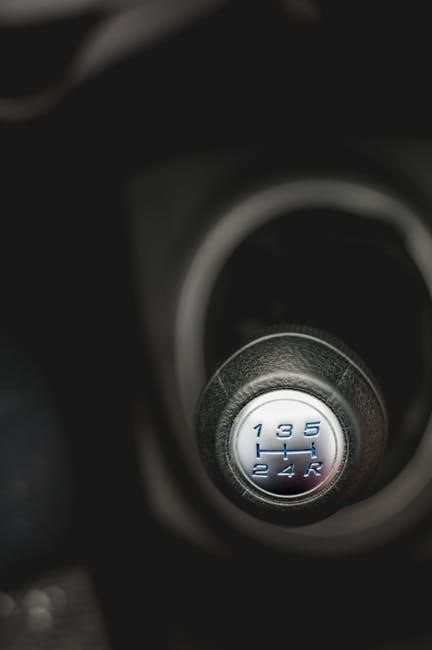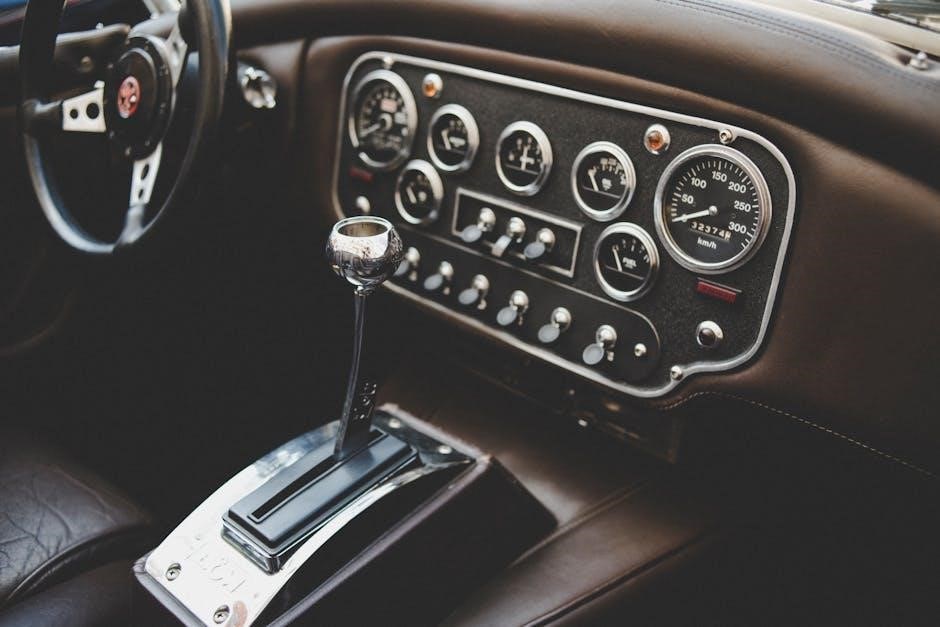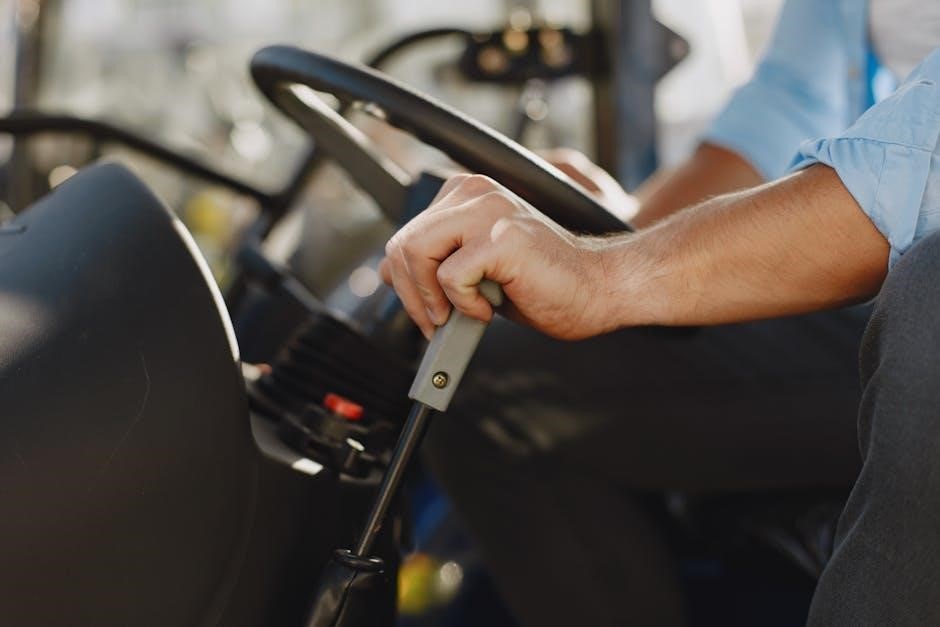
Adjusting the Clutch on a 1950 3-Speed Manual Transmission: A Step-by-Step Guide
Adjusting the Clutch Linkage
Adjust the clutch linkage to ensure proper free play. Locate the adjustment rod and clevis pin. Loosen the locknuts and measure the free play at the pedal. Aim for 1 inch of free play before resistance. Turn the rod clockwise to shorten or counterclockwise to lengthen. Tighten the locknuts securely after adjustment.
Adjusting the clutch on a 1950 3-speed manual transmission is a straightforward process that ensures smooth gear shifts and optimal performance. The clutch system plays a critical role in disconnecting and reconnecting engine power to the transmission‚ allowing for seamless control during acceleration and deceleration. Proper adjustment is essential to maintain the longevity of the clutch components and prevent premature wear.
In this guide‚ we will walk you through the steps to adjust the clutch linkage‚ check free play‚ and ensure the clutch engages smoothly. Whether you’re restoring a classic vehicle or maintaining your daily driver‚ understanding how to adjust the clutch is a valuable skill. The 1950 3-speed manual transmission‚ with its simple yet durable design‚ requires periodic adjustments to maintain peak functionality. By following the steps outlined in this guide‚ you’ll be able to fine-tune your clutch system and enjoy better control over your vehicle.
The process involves inspecting key components such as the clutch pedal‚ linkage‚ and cable‚ as well as ensuring proper alignment and free play. With the right tools and a bit of patience‚ you can achieve the perfect balance between pedal feel and clutch engagement. This guide is designed to be user-friendly‚ providing clear instructions for both novice and experienced mechanics alike.
Before starting‚ familiarize yourself with the components and their functions. This will help you identify potential issues and ensure a successful adjustment. Remember‚ proper maintenance is key to preserving the performance and reliability of your vehicle’s transmission system. Let’s dive in and explore how to adjust your clutch like a pro!
Understanding the Clutch System

The clutch system in a 1950 3-speed manual transmission is a mechanical setup designed to engage and disengage power between the engine and the transmission. It consists of a clutch pedal‚ linkage‚ cable‚ pressure plate‚ and clutch disc. When the pedal is pressed‚ it releases the clutch‚ allowing the driver to shift gears smoothly without grinding or stalling the vehicle.
The clutch pedal is connected to a linkage system that operates the clutch fork. This fork moves the pressure plate‚ which then releases the clutch disc from the flywheel. When the pedal is released‚ the pressure plate engages the disc with the flywheel‚ reconnecting engine power to the transmission. Proper adjustment ensures smooth engagement and prevents excessive wear on the components.
The clutch system relies on free play in the pedal to function correctly. Free play is the distance the pedal can travel before it starts to engage the clutch. Too little or too much free play can lead to poor shifting‚ premature wear‚ or difficulty in finding neutral. Understanding how these components interact is essential for making accurate adjustments and maintaining the system’s performance.
In the 1950 3-speed manual transmission‚ the clutch is a single-plate design‚ making it relatively simple compared to modern multi-plate systems. However‚ it still requires careful adjustment to ensure proper engagement and disengagement. The clutch cable or linkage must be properly aligned and lubricated to avoid binding or uneven wear.
Regular inspection of the clutch system is crucial to identify potential issues early. Worn or damaged components‚ such as a warped pressure plate or a cracked clutch disc‚ can lead to costly repairs if left unaddressed. By understanding the clutch system’s operation and maintenance needs‚ you can extend its lifespan and enjoy reliable performance from your classic vehicle.
Locating Components
Before adjusting the clutch‚ it’s essential to familiarize yourself with the components involved in the system. The clutch pedal is located on the far left of the driver’s footwell‚ under the dashboard. This pedal is connected to a linkage system that runs down to the transmission. The linkage includes a series of rods and joints that transmit the pedal’s movement to the clutch fork.
The clutch fork is located inside the transmission bellhousing and is attached to the clutch release bearing. The release bearing is responsible for pressing against the pressure plate to disengage the clutch. The pressure plate and clutch disc are mounted on the flywheel‚ which is attached to the engine’s crankshaft. Together‚ these components work to engage and disengage power between the engine and transmission.
To access the adjustment points‚ you’ll need to locate the equalizer bar or cross shaft‚ which connects the clutch pedal linkage to the clutch fork. This bar is typically found near the base of the transmission and may require some disassembly of the linkage to access. The adjustment points are usually marked by nuts or bolts that can be loosened to modify the free play in the system.

Understanding the layout of these components is crucial for making accurate adjustments. The clutch cable or linkage must be properly aligned to ensure smooth operation. If the components are misaligned or worn‚ it can lead to poor clutch performance. Always refer to the service manual or manufacturer’s specifications for precise locations and adjustment procedures.

Take your time to thoroughly inspect and locate each component before starting the adjustment process. This will help you avoid confusion and ensure that your adjustments are effective in restoring proper clutch function to your 1950 3-speed manual transmission.
Checking Clutch Pedal Free Play
Checking the clutch pedal free play is a critical step in ensuring proper clutch operation. Free play refers to the distance the clutch pedal can travel before it starts to engage the clutch mechanism. Excessive or insufficient free play can lead to poor clutch performance‚ difficulty shifting gears‚ or premature wear on components.
To check the free play‚ locate the clutch pedal and measure the distance it travels before resistance is felt. This is typically done by pressing the pedal gently until it begins to engage the clutch. Use a ruler or measuring tool to record the distance. For a 1950 3-speed manual transmission‚ the recommended free play is usually around 1 to 1.5 inches.
If the free play is incorrect‚ adjustments will be needed. To do this‚ locate the adjustment point on the clutch linkage‚ usually found near the clutch fork or equalizer bar. Loosen the locknuts on the adjustment rod‚ then turn the rod clockwise to reduce free play or counterclockwise to increase it. Tighten the locknuts securely after making the adjustment.
It’s important to test the clutch pedal after adjustment to ensure the free play is within the specified range. If the free play is too little‚ the clutch may not fully disengage‚ causing grinding or difficulty shifting gears. If there’s too much free play‚ the clutch may engage too slowly‚ leading to hesitation or stalling.

Always refer to the vehicle’s service manual or manufacturer’s specifications for precise free play measurements; Accurate adjustment ensures smooth clutch operation‚ prolongs component life‚ and maintains optimal drivability for your classic 3-speed manual transmission.
Adjusting the clutch linkage is essential for proper clutch engagement and disengagement. Start by locating the adjustment rod‚ typically connected to the clutch pedal and fork. Loosen the locknuts on the rod to allow movement. Measure the free play at the pedal‚ aiming for 1 to 1.5 inches of travel before resistance is felt.
To adjust‚ turn the rod clockwise to shorten it (reducing free play) or counterclockwise to lengthen it (increasing free play). Tighten the locknuts securely after reaching the desired adjustment. Ensure the clutch pedal operates smoothly and the transmission shifts effortlessly.
If the linkage is out of alignment‚ adjust the clevis pin or equalizer bar to restore proper geometry. This ensures the clutch fork moves evenly and prevents uneven wear on the throwout bearing. Always test the clutch pedal after adjustments to confirm proper engagement and disengagement.
For optimal performance‚ ensure the linkage is clean and well-lubricated. Avoid over-tightening‚ as this can lead to premature wear or damage. Regular adjustments maintain smooth shifting and extend the life of the clutch system in your 1950 3-speed manual transmission.
Setting the Bite Point
The bite point on a 1950 3-speed manual transmission is the point at which the clutch begins to engage. To set it correctly‚ start by understanding that the bite point is where the clutch disc first makes contact with the flywheel. If the bite point is too high‚ the clutch may engage too abruptly‚ leading to jerky starts. Conversely‚ if it’s too low‚ the pedal may need to be released too much‚ which can be uncomfortable for the driver.
Adjustments are typically made to the clutch linkage or pedal mechanism. Locate the adjustment rod or mechanism that controls the clutch engagement. This may involve a knob‚ bolt‚ or nut that regulates how much the clutch engages as the pedal is released. The goal is to find the optimal point where the clutch begins to grab smoothly without causing sudden jerks.
Free play in the clutch pedal is crucial for proper bite point adjustment. Free play refers to the distance the pedal can move before it starts to engage the clutch. If there’s too much free play‚ the bite point will be too low. To adjust this‚ find the locknut and adjusting nut on the pedal or linkage. Loosen the locknut and turn the adjusting nut to set the desired free play. Aim for about 1 to 1.5 inches of free play for optimal engagement.
After making adjustments‚ test the bite point by driving the car. Pay attention to how the clutch feels as you press and release it. Smooth engagement without jerking indicates the bite point is set correctly. If adjustments affect gear shifting‚ fine-tune the linkage to ensure proper gear alignment and smooth transitions.
Refer to the service manual for specific diagrams and instructions‚ as the exact adjustment points and measurements may vary. Use basic tools like a wrench or pliers for adjustments. With careful tuning‚ you can achieve a smooth and comfortable clutch engagement for your 1950 3-speed manual transmission.
Inspecting the Clutch Cable/Hydraulic System
Inspecting the clutch cable or hydraulic system is essential for ensuring smooth operation and preventing premature wear. For cable-operated clutches‚ check the clutch cable for signs of fraying‚ kinking‚ or corrosion. If damaged‚ the cable must be replaced immediately‚ as it can fail during operation‚ leaving you unable to shift gears.
For hydraulic systems‚ inspect the master and slave cylinders for any signs of leaks. Hydraulic fluid leaks can lead to a loss of pressure‚ causing the clutch to fail to disengage properly. Look for fluid droplets on the cylinders‚ hoses‚ or surrounding components. If a leak is found‚ repair or replace the faulty seals or components promptly;
Next‚ check the clutch fluid level if your system is hydraulic. The reservoir should be filled to the recommended level‚ as specified in the service manual. Low fluid levels can result in poor clutch performance or complete failure to engage.
Examine the clutch slave cylinder and master cylinder for proper alignment and connection to the clutch pedal or linkage. Misaligned components can cause uneven wear or improper clutch engagement. If the system feels spongy or unresponsive‚ it may indicate air in the hydraulic lines‚ which requires bleeding to restore proper function.
Finally‚ test the system by depressing the clutch pedal several times and checking for consistent resistance and smooth engagement. If the pedal feels soft or the clutch drags‚ further investigation is needed. Regular inspections help prevent unexpected failures and ensure reliable performance from your 1950 3-speed manual transmission.
Testing the Clutch

After completing the adjustments‚ it is crucial to test the clutch to ensure proper operation. Start by checking the clutch pedal’s free play and resistance. Press the pedal several times to feel for smooth‚ consistent engagement and disengagement. If the pedal feels spongy or uneven‚ further inspection may be needed.
Next‚ determine the clutch’s bite point by slowly releasing the pedal while listening for the point where the clutch begins to engage. The bite point should be consistent and not too high or low on the pedal travel. If the engagement feels abrupt or vague‚ additional fine-tuning may be required.

Test the clutch in various gears to ensure smooth shifting. Start with first gear and gradually progress through the gears‚ paying attention to how the clutch engages and disengages during each shift. If the clutch slips or drags‚ it may indicate improper adjustment or worn components.

Drive the vehicle at a moderate speed and test the clutch under light acceleration and deceleration. Listen for any unusual noises‚ such as grinding or chatter‚ which could signal issues with the clutch or transmission. If the vehicle stalls or hesitates during gear changes‚ the bite point may need adjustment.

Finally‚ check for proper disengagement by fully depressing the pedal and ensuring the engine does not stall when shifting into gear. If the engine continues to run‚ the clutch may not be fully disengaging‚ requiring further inspection of the linkage or hydraulic system.
A thorough test ensures the clutch operates smoothly‚ providing reliable performance and preventing premature wear on the transmission components.
Troubleshooting Common Issues
When adjusting the clutch on a 1950 3-speed manual transmission‚ several common issues may arise. One of the most frequent problems is the clutch slipping‚ which occurs when the clutch fails to fully engage‚ causing the engine to rev without increasing speed. This is often due to worn clutch facings or incorrect adjustment of the linkage. To resolve this‚ ensure the linkage is properly adjusted and inspect the clutch plate for wear. If damaged‚ the clutch may need replacement.

Another issue is the clutch dragging‚ where the clutch does not fully disengage‚ making it difficult to shift gears smoothly. This is typically caused by excessive free play or misalignment in the linkage. Adjust the free play to the recommended 1 inch and check for any bent or damaged components in the linkage system. Lubricating the pivot points can also help improve smooth operation.
Noise during clutch operation‚ such as grinding or chatter‚ indicates worn or misaligned components. Inspect the clutch release bearing and fork for damage or misalignment. If the noise persists‚ it may be necessary to replace the clutch or related parts.
Difficulty shifting into gear‚ especially first or reverse‚ can be caused by improper bite point adjustment. Ensure the bite point is set correctly by adjusting the linkage to achieve smooth engagement and disengagement. If the problem persists‚ check the clutch cable or hydraulic system for leaks or damage.
Regular maintenance and inspection of the clutch system can prevent these issues from arising. Always refer to the service manual for specific instructions and torque specifications to ensure proper adjustment and repair.
Adjusting the clutch on a 1950 3-speed manual transmission is a straightforward process that requires attention to detail and a basic understanding of the clutch system. By following the steps outlined in this guide‚ you can ensure proper free play‚ linkage adjustment‚ and bite point setting. Regular maintenance and inspection of the clutch cable‚ hydraulic system‚ and linkage components will help prevent common issues like slipping‚ dragging‚ or difficulty shifting gears.
If you encounter problems during or after adjustment‚ troubleshooting techniques such as checking for worn or misaligned parts‚ inspecting the clutch plate‚ and lubricating pivot points can help resolve them. Always refer to the vehicle’s service manual for specific torque specifications and adjustment procedures to ensure accuracy and avoid damage to the transmission or clutch assembly.
Proper clutch adjustment not only improves drivability but also extends the life of the clutch and related components. With patience and careful execution‚ you can achieve smooth‚ precise gear shifts and maintain the performance of your classic vehicle. Remember‚ regular maintenance is key to keeping your 1950 3-speed manual transmission in optimal condition.